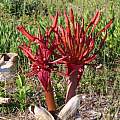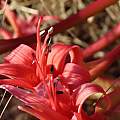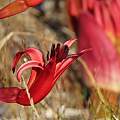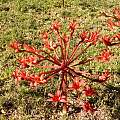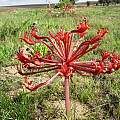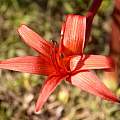Brunsvigia is a South African genus of Amaryllidaceae which grow in semi-arid regions. There are both winter rainfall and summer rainfall species that flower with and without leaves at the time. Some produce amazing floral displays. For more information about this genus see the Brunsvigia main page and index.
Brunsvigia species a-g - Brunsvigia species h-m
Brunsvigia namaquana D.Müll.-Doblies & U.Müll.-Doblies is a miniature species (to 10 cm) found in quartzite and granite outcrops in Namaqualand. It has zygomorphic flowers and leaves covered in golden bristles, two characteristics not common among species of Brunsvigia. In mature plants the 3-4, occasionally 2, leaves are flat on the ground. The 4 to 10 pale pink with a yellow-green throat flowers are in a small head. It is similar to Brunsvigia radula. Photo 1 is of a seedling leaf already showing its bristles, by Uluwehi Knecht. Photo 2-3 were taken by Nhu Nguyen showing progressive building of leaves but still many years from blooming. The last photo contributed by Shoal Creek Succulents.
Photos below from Bert Zaalberg of plants grown from seed collected in the Richtersveld National Park, South Africa.
Brunsvigia natalensis Baker is a summer rainfall bulb that occurs in the Eastern regions of South Africa and is found scattered in grassland, on rock outcrops, up to 2280 m. It has 2 to 6 flattish to semi-erect leaves that are produced with the flowers. There are 30 to 60 deep pink to red flowers in the inflorescence. Flowering occurs from October to January. It is usually a smaller plant with a smaller bulb and with narrower leaves than Brunsvigia radulosa. Photo from iNaturalist taken by Jenny Potgieter in November in KwaZulu-Natal and shared under a CC BY-NC license.
Brunsvigia orientalis (L.) Aiton ex Eckl. is a large plant (to 50 cm) found on sandy flats along the coast, riverbeds or inland sand plumes in predominantly low altitude winter rainfall areas of the Western Cape. Flowers are adapted to sunbird pollination. This large bulb can carry up to 50 crimson flowers in a large rounded umbel. The 4-8 oblong leaves appear after the flowers die and are flat on the ground. The upper surface is usually velvety. Flowering occurs February to April. Photos below were taken by Alan Horstmann. The first one was taken in habitat.
Photos below were taken by Cameron McMaster in the Overberg. In the last photo it was flowering at the same time as Haemanthus coccineus.
The first photo of flowers was taken by Bill Dijk and the second one of the leaves shortly after they have reappeared in fall (with Cyclamen coum) was taken by Mary Sue Ittner. The third photo from Uluwehi Knecht is of seeds next to a U.S. 25 cent piece (2.5 cm wide). The last photo shows 8-week-old seedlings sown in early 2009 by Byron Amerson.
Brunsvigia pulchra (W.F.Barker) D.Müll.-Doblies & U.Müll.-Doblies is a very handsome species formerly classified as Boophone pulchra found in Namaqualand on steep or gentle slopes in gravely or granite derived soils. Growing to 30 cm, it has 5-7 prostrate strap shaped leaves with red margins that appear after the first good winter rains and in dry years don't appear at all. It has a compact inflorescence of 30-70 deep rose-pink flowers with upright pedicels. In this regard it is different from other species that have flower stalks that radiate outwards (instead of facing upwards as this species does.) The stalks only lengthen and radiate after the flowers have faded. It flowers March to May in the hot dry fall and before the leaves. The first two photos from iNaturalist were taken by Judd Kirkel in April in Namaqualand and shared under a CC BY-NC license. The last photo is of a 3 year old seedling, by Uluwehi Knecht.
Brunsvigia radula (Jacq.) W.T.Aiton is a small plant (to 10 cm) with two pressed down leaves covered with straw colored bristles and pink (lemon-yellow near the base) flowers. Tepals curve in the upper half and stamens are as long as the tepals. It grows in crevices of dolomite outcrops in Namaqualand and flowers February to April. Photo 1 by Alan Horstmann. Photos 2-3 of the leaves from iNaturalist taken by Nick Helme in the Western Cape and shared under a CC BY-SA license. Photo 4 from Rachel Saunders shows this plant in seed. The last photo from Chad Cox shows the first flowering of a plant he has grown from seed.
Brunsvigia radulosa Herb. is widespread in grassland in the summer rainfall, higher altitude regions of the Eastern Cape and the Orange Free State. It has spreading prostrate leaves and pink to red flowers in January or February. The flowers are insect pollinated. Photos taken in the Eastern Cape by Cameron McMaster. The third photo shows the prostrate leaves that appear in winter, by Uluwehi Knecht. Photo #4 by Nhu Nguyen shows seeds which already have sent out their radicles. The fifth photo shows one-month-old seedlings sown by Byron Amerson.
Brunsvigia striata W.T.Aiton (syn. Brunsvigia minor Lindl.) is found on heavy or humus-rich, often stony soils. Origin is northwestern, southwestern Cape and the western Karoo, but this species is also listed for the Eastern Cape so may have a variety of rainfall patterns, but mostly winter rainfall. It grows from 15 to 35 cm and has 4 to 6 elliptical leathery flat leaves that appear after the flowers have faded. It has 8 to 30 pale to reddish pink flowers that are pollinated by carpenter bees. It flowers March to April. The first photo by Bill Dijk. The second photo was taken by Andrew Harvie. The third taken by Cameron McMaster is one from a large population near Cape Infanta which is at the mouth of the Breede River in the Southern Cape. The fourth photo from the book Plants of the Klein Karoo courtesy of Jan and Anne Lise Schutte-Vlok. The last picture is of seeds taken by Uluwehi Knecht next to a U.S. 25 cent piece (2.5 cm wide).
Brunsvigia sp. is from Namibia. It is found in the collection at the UC Botanical Garden. Photos by Nhu Nguyen.
Brunsvigia undulata F.M.Leight. is found in grassland in the Eastern Cape. It has many shiny blue-grey-green wavy leaves that are produced with the flowers. There are 35-80 deep red flowers in the inflorescence. Tepal lobes are recurved and stalks erect. It blooms January to February. Photos from iNaturalist in the public domain taken by Peter Warren in January in KwaZulu-Natal.
Brunsvigia index - Brunsvigia species a-g - Brunsvigia species h-m










